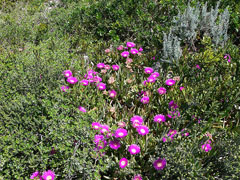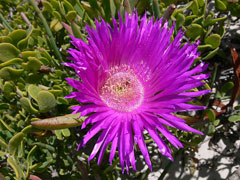 |
|
http://commons.wikimedia.org/wiki/User:Amrum |
 |
| http://commons.wikimedia.org/wiki/User:Amrum |
Translate this page:
Summary
Physical Characteristics

 Carpobrotus acinaciformis is an evergreen Perennial growing to 0.1 m (0ft 4in) by 1 m (3ft 3in).
Carpobrotus acinaciformis is an evergreen Perennial growing to 0.1 m (0ft 4in) by 1 m (3ft 3in).
See above for USDA hardiness. It is hardy to UK zone 9 and is frost tender. It is in leaf all year, in flower from May to July, and the seeds ripen from August to September. The species is hermaphrodite (has both male and female organs) and is pollinated by Bees.
Suitable for: light (sandy) soils, prefers well-drained soil and can grow in nutritionally poor soil. Suitable pH: mildly acid, neutral and basic (mildly alkaline) soils and can grow in saline soils.
It cannot grow in the shade. It prefers dry or moist soil and can tolerate drought. The plant can tolerate maritime exposure.
UK Hardiness Map
US Hardiness Map
Synonyms
Mesembryanthemum acinaciforme.
Plant Habitats
Ground Cover; Cultivated Beds; South Wall. By. West Wall. By.
Edible Uses
Edible Parts: Fruit Leaves
Edible Uses:
Fruit - raw[1, 61, 89]. There is very little flesh in the fruit and it must be fully ripe otherwise it is very astringent[K]. Insipid[46, 105, 177]. Leaves - raw or cooked[2, 173]. Very mucilaginous, we find it very hard to enjoy them[K].
References More on Edible Uses
Medicinal Uses
Plants For A Future can not take any responsibility for any adverse effects from the use of plants. Always seek advice from a professional before using a plant medicinally.
None known
References More on Medicinal Uses
The Bookshop: Edible Plant Books
Our Latest books on Perennial Plants For Food Forests and Permaculture Gardens in paperback or digital formats.

Edible Tropical Plants
Food Forest Plants for Hotter Conditions: 250+ Plants For Tropical Food Forests & Permaculture Gardens.
More

Edible Temperate Plants
Plants for Your Food Forest: 500 Plants for Temperate Food Forests & Permaculture Gardens.
More

More Books
PFAF have eight books available in paperback and digital formats. Browse the shop for more information.
Shop Now
Other Uses
Fire retardant Soil stabilization
Planted in maritime areas to prevent soil erosion in sandy soils and on steep banks[200]. Plants form a dense carpet and make an effective ground cover[208]. The plant is moderately fire-resistant and can be used in barrier plantings to prevent the spread of forest fires[200].
Special Uses
Ground cover
References More on Other Uses
Cultivation details
Requires a well-drained sandy soil in a sunny position[1, 200]. Plants can be grown on dry walls or in the flower border[166]. Established plants are very drought resistant[200]. Very resistant to wind and salt spray[166]. Moderately fire-retardant[200]. Plants are not very frost resistant and can be killed by temperatures below about -2°c. They have naturalized themselves on cliffs along the coast of S. Britain but do not succeed inland unless grown in a sunny sheltered position[200]. A vigorous prostrate plant, rooting as it spreads. The flowers only open in the afternoon[200].
References Carbon Farming Information and Carbon Sequestration Information
Temperature Converter
Type a value in the Celsius field to convert the value to Fahrenheit:
Fahrenheit:
The PFAF Bookshop
Plants For A Future have a number of books available in paperback and digital form. Book titles include Edible Plants, Edible Perennials, Edible Trees,Edible Shrubs, Woodland Gardening, and Temperate Food Forest Plants. Our new book is Food Forest Plants For Hotter Conditions (Tropical and Sub-Tropical).
Shop Now
Plant Propagation
Seed - surface sow March to June in a greenhouse. Lower night-time temperatures are beneficial. The seed usually germinates in 7 - 10 days at 23°c[138]. When they are large enough to handle, prick the seedlings out into individual pots and grow them on in a greenhouse for at least their first winter. Plant them out into their permanent positions in late spring or early summer, after the last expected frosts. Cuttings at any time during the growing season. Allow the cutting to dry in the sun for a day or two then pot up in a very sandy mix. Very easy[K].
Other Names
If available other names are mentioned here
Native Range
AFRICA: South Africa (Western Cape)
Weed Potential
Right plant wrong place. We are currently updating this section.
Please note that a plant may be invasive in one area but may not in your area so it's worth checking.
Conservation Status
IUCN Red List of Threatened Plants Status :

Growth: S = slow M = medium F = fast. Soil: L = light (sandy) M = medium H = heavy (clay). pH: A = acid N = neutral B = basic (alkaline). Shade: F = full shade S = semi-shade N = no shade. Moisture: D = dry M = Moist We = wet Wa = water.
Now available:
Food Forest Plants for Mediterranean Conditions
350+ Perennial Plants For Mediterranean and Drier Food Forests and Permaculture Gardens.
[Paperback and eBook]
This is the third in Plants For A Future's series of plant guides for food forests tailored to
specific climate zones. Following volumes on temperate and tropical ecosystems, this book focuses
on species suited to Mediterranean conditions—regions with hot, dry summers and cool, wet winters,
often facing the added challenge of climate change.
Read More
Expert comment
Author
(L.)L.Bolus.
Botanical References
200
Links / References
For a list of references used on this page please go here
Readers comment